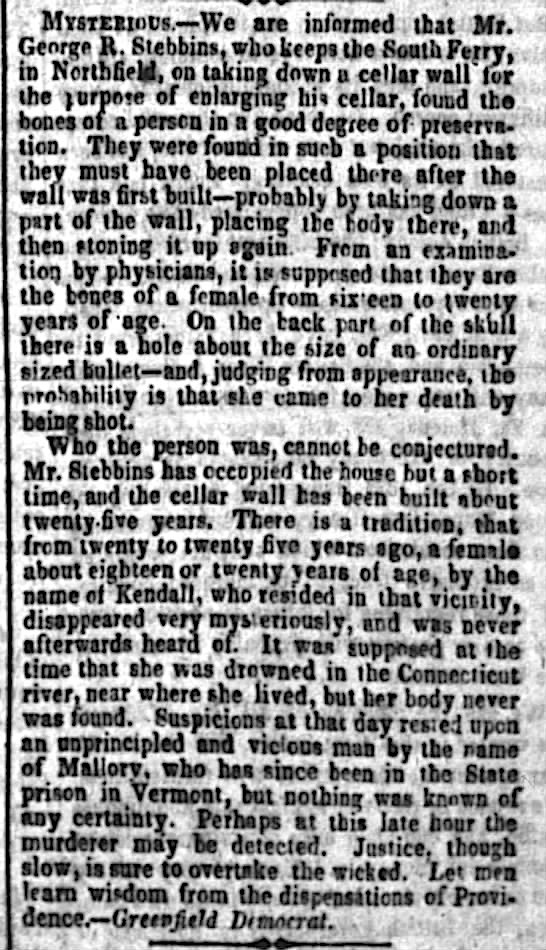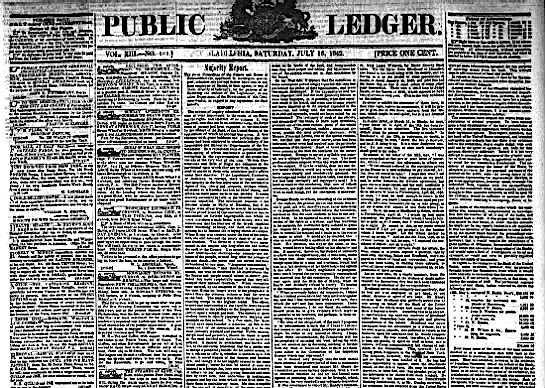George Stebbins was tearing down a stone wall in the cellar of his home in Northfield, Massachusetts when he uncovered the bones. A skull emerged first, then the spine and the bones of the arms and legs. The remains were packed together in a space measuring less than three feet, suggesting the body had been dismembered or had decayed to a skeleton before being interred. Had Stebbins, who operated a ferry on the Connecticut River just inside the state’s border with New Hampshire and Vermont, disturbed a forgotten grave? Or was there a more sinister explanation for the discovery?
“The condition of the wall appeared as if part of the wall had been removed,” he informed the Vermont Phoenix, “and the human body crowded in, and the wall, unworkman-like, replaced.” He emphasized the term “unworkman-like” in his letter to the newspaper in nearby Brattleboro, published after press reports of the discovery circulated in the summer of 1842. The body, he clearly believed, had been entombed behind the wall by someone who was either unskilled in building stone walls or had been in a hurry to hide the remains.
___________________________________
This story originally appeared in Ellery Queen’s Mystery Magazine.
___________________________________
The Greenfield Democrat, published in a neighboring town, was the first to break the news in mid-July. Under the heading “Mysterious,” the paper noted that the bones were “in a good degree of preservation” and must have been deposited behind the wall within the previous twenty-five years – after the home was built and before Stebbins moved in, a short time before he began to expand the cellar. Physicians summoned to the scene concluded they were the bones of a woman who had been between the ages of sixteen and twenty when she died. And there was evidence of foul play.
 The republished report on the discovery of bones behind a cellar wall in Northfield, Massachusetts.
The republished report on the discovery of bones behind a cellar wall in Northfield, Massachusetts.
“On the back part of the skull there is a hole about the size of an ordinary sized bullet,” the Democrat told its readers, “and, judging from appearance, the probability is that she came to her death by being shot.” The paper eagerly offered the possible identities of the victim and her killer. A young woman with the surname Kendall had disappeared in the Northfield area about two decades earlier; her body had never been found and it had been thought she had drowned in the river. There had been rumors at the time, however, that “an unprincipled and vicious man by the name of Mallory,” who later served time in the Vermont state prison, was responsible.
“Perhaps at this late hour the murderer may be detected,” the newspaper hoped. “Justice, though slow, is sure to overtake the wicked. Let men learn wisdom from the dispensations of Providence.”
Details of Stebbins’ discovery of a possible victim of murder proved to be irresistible to newspaper editors in far-flung towns and cities. The Boston Post, the Charleston Daily Courier, and Pennsylvania’s Sunbury Gazette were among the papers that picked up all or part of the story, and it was republished as far away as Holly Spring, Mississippi. Philadelphia residents who reached for the Saturday July 16 edition of their Public Ledger would have been unlikely to miss the Greenfield Democrat’s report – it was reproduced verbatim on the front page.
The story would have cried out to a writer who had been living in Philadelphia for four years and whose name often appeared in the Public Ledger. The gruesome discovery of the bones, the suspicions of a foul murder, the fiendish attempt to conceal the remains and evidence of the crime – these were features that would have appealed to his taste for the macabre. There was something, however, that Edgar Allan Poe would need in order to transform the news report into a gothic tale of horror that plumbed the depths of guilt and depravity. A cat. A black cat.
* * *
“The Black Cat” was first published in the Saturday Evening Post in August 1843, a little more than a year after George Stebbins dug up the bones. Like “The Tell-Tale Heart,” published the previous January, it’s framed as a murderer’s confession to his crime. On the eve of his execution, the unnamed narrator of “The Black Cat” relates how excessive drinking transformed him from a person “noted for the docility and humanity of my disposition” into a violent abuser filled with “the fury of a demon.” He admits to inflicting “personal violence” on his wife and torturing his black cat, Pluto, cutting out one of its eyes and ultimately killing the animal.

Wracked with remorse but unable to control his drinking and destructive behavior, the narrator finds and adopts another one-eyed black cat. But his new pet reminds him of the violence he had inflicted on Pluto, and he soon loathes the animal. Heading into his cellar with his wife on an errand, he almost trips over the cat and his rage explodes. He seizes an axe to kill the cat, but his wife intervenes. “Goaded, by the interference, into a rage more than demonical,” he confesses, he “buried the axe in her brain.”
To conceal the crime, he opens a cavity in the cellar wall and puts her body inside. After carefully replacing and re-mortaring the stones “so that no eye could detect anything suspicious,” he realizes the cat is missing. The police investigate the woman’s disappearance and even search the cellar, oblivious to the fact her remains are only inches away. The narrator, in what he calls a “frenzy of bravado,” remarks on the solid construction of the cellar walls and taps the stones hiding the corpse. A muffled sound from within the wall swells into an “inhuman … wailing shriek.” The officers tear down the wall and find his wife’s body. The black cat, mistakenly walled up with the remains and the source of the shrieking, is perched on her head.
“The Black Cat” is considered a Poe classic. Could it have been based on a real event? The Saturday Evening Post hinted that it was, noting in an introduction when the story first appeared that it combined “probable events with improbable circumstances, so blended with the real that all seems plausible.” Reviewers at the time either loved it or hated it. The United States Gazette hailed it as “a thrilling original tale” while London’s Literary Gazette dismissed it as “impossible and revolting.” Blackwood’s Magazine was confident the story was no more than a “wild and horrible invention.” Poe biographer Hervey Allen agreed, writing in the 1930s that “The Black Cat” was “the mad realization of a dream.”
Poe scholar John E. Reilly appears to have been the first to identify the Northfield discovery as a possible inspiration for “The Black Cat.” A professor of English at the College of the Holy Cross in Worcester, Massachusetts and one of the founding members of the Poe Studies Association, Reilly published a paper connecting the case to the story in the journal Nineteenth-Century Literature in 1993.
There are marked differences, of course. The Northfield case appeared to be a shooting, there was no suggestion a man had killed his wife, and the police were not in attendance when the bones were found. There was no cat, let alone a black one (Poe’s narrator called them “witches in disguise”). Reilly acknowledged the discrepancies but argued that “the nucleus of Poe’s episode and the nucleus of the news item are identical: the body of a woman who died by a puncture of the skull is discovered immured in a basement.”
Reilly marshaled some compelling circumstantial evidence to support his claim. The Philadelphia Public Ledger was a fan of Poe’s work – an 1840 item in the paper lauded his “extraordinary powers” and “originality of genius” – and he likely was a subscriber or a frequent reader, ensuring he did not miss such generous praise. And the Public Ledger’s report on the discovery of the bones appeared only months before he wrote “The Black Cat.” While the story was not published until the summer of 1843, Poe had read the manuscript of the story to Felix Darley, an illustrator he worked with, in the fall of 1842.
 The front page of the July 16, 1842 issue of the Philadelphia Public Ledger.
The front page of the July 16, 1842 issue of the Philadelphia Public Ledger.
And it would not have been the first time Poe drew on news reports of a gruesome crime as he crafted his equally gruesome stories. His most infamous transformation of fact into fiction was the sensational murder of a young woman named Mary Rogers in New York City in 1841. Poe renamed her Marie Roget, moved the location to Paris, and put his detective C. Auguste Dupin on the case, but the story was, as he put it, “a series of nearly exact coincidences” that mirrored the real-life crime.
* * *
The identity of the woman buried in ferryman George Stebbins’ cellar, and how and when she died, remained a mystery. In September 1842, the Gazette in Bennington, Vermont published a letter from a group of Northfield residents who swore that no woman named Kendall had ever lived in the community, let alone disappeared without a trace two decades earlier. What’s more, they asserted, the man named Mallory who had been accused of her murder would have been no more than twelve years of age at that time. The Gazette’s editor chided the Greenfield Democrat for accusing Mallory of “so horrid a crime” without proof and advised the paper to “clear Mr. M. from these unjust suspicions.”
Other Northfield residents offered a possible explanation for the discovery. One insisted that Stebbins’ house had been built on the burying ground for a nearby fort erected more than a century earlier, during frontier wars with indigenous tribes. “Human bones have frequently been dug and ploughed up here,” reported a Mr. Tiffany, who claimed he had been present when the cellar was originally dug. Bones discovered during construction, he said, had been gathered up and deposited behind the wall, where Stebbins had found them.
No investigation appears to have been launched to determine the age of the bones or to look for evidence of foul play. A letter to the editor published shortly after the discovery in another Greenfield newspaper, the Gazette and Courier, called for a coroner’s jury to be empaneled. The writer, who used the pseudonym “Anti Cryptamia,” claimed “there had been in former years a continued and very offensive smell” emanating from Stebbins’ cellar. A search of surviving issues of newspapers published in the area, however, turned up no reports of an inquest or other official action.
If the bones were those of a murder victim, the Greenfield Democrat’s belief that justice was certain to overtake the wicked was, in this case, misplaced. There’s no trace of the “unprincipled and vicious” Mallory, either – although he may have been the John Mallory arrested, along with other members of a “den of counterfeiters,” near the New York-Massachusetts border in 1846.
Did a killer in the New England town of Northfield – unlike Poe’s tormented and unlucky narrator – get away with murder? Possibly. Was Poe’s inspiration for “The Black Cat” a news report on the discovery of bones behind a cellar wall? You be the judge.




















